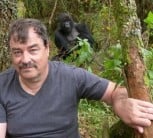University of Pretoria (UP) scientists have contributed to discovering how the naked mole rat is able to withstand heart attacks and fend off bowel cancer, two of the most fatal human ailments in the developed world. Their findings were published recently in two Nature Communications papers.
Prof Nigel Bennett and Dr Daniel Hart, co-authors on both papers and experts in mole rat evolution at UP’s Department of Zoology and Entomology, say the findings add to a long list of mole rat “superpowers” that have already been discovered, including slower ageing, natural contraception and the ability to bypass pain responses – all of which are of great interest to biomedical researchers working on human health.
“The main reason we believe mole rat have these ‘superpowers’ is because they live in such harsh environments underground,” Dr Hart says, adding that there is very little oxygen underground and that the roots mole rats eat are tough, fibrous and even toxic to most mammals.
He says the best place to study colon cancer in mammals, a disease characterised by cell division gone wrong, is in the intestinal crypt, a small pocket at the base of the intestine where stem cells are found. These cells normally begin to divide, and specialise into intestinal cells that line and protect the gut.
“If something is wrong with the stem cells, the animal has big problems,” Dr Hart says. Mice, for instance, will die when given a cancer-causing agent that targets those stem cells.
But not the naked mole rat.
“We saw no physical damage in the animal when we attempted to induce the precursor to colon cancer, and no signs of distress – just business as usual,” Dr Hart explains. When they had a closer look at the intestinal crypt using specialised scanning techniques, they found that the stem cells had simply stopped dividing to protect themselves against damage from the cancer-causing chemical.
“It’s like [the stem cells] batten down the hatches until the storm is gone; it’s as if they go into a dormant stage,” Dr Hart says. “Then when the stressor has left, they come out and start dividing again.”
The researchers also found more intestinal adult stem cells, and more cells that protect against gut cancers and degradation due to ageing. This is not surprising, Dr Hart says, because scientists have already noticed that all mole rat species have a very low incidence of cancer, so it’s likely these kinds of mechanisms confer protection against all cancers, not just colon cancer.
Much of the experimentation behind the cancer discovery was done at UP at the specialised mole rat laboratory established by Prof Bennett. Dr Hart says the work would have been impossible without their collaborators from the University of Oxford in the UK, led by Dr Shazia Irshad and Dr Shamir Montazid, as well as Dr Sheila Bandyopadhyay of Rutgers University in the US.
The UP lab, which was recently featured in the “Dark” episode of the BBC documentary series Mammals, is home to about eight different mole rat species, many of which are unique to South Africa and exclusively studied there. International researchers working on more common global species like the naked mole rat often look to UP for evolutionary comparisons and cross-species studies.
“We have opportunities to work with some of the best scientists and laboratories in the world because we have these mole rats,” Dr Hart says. “We aren’t just seen as a source of material or source of potential, but as equal collaborators.”
To bring the bowel cancer finding closer to human biomedical research, the genetic markers must be pinpointed next, Dr Hart explains, so that gene therapies for equivalent human genes can be investigated. This is exactly what the international team of scientists studying naked mole rat heart attacks have done: they mapped the genetic adaptations that keep a naked mole rat’s heart beating despite it being deprived of oxygen and nutrients.
In humans and other mammals, a heart attack occurs when the heart’s oxygen and food supply is interrupted, due to a blockage in blood vessels, for instance. When researchers tried to induce a heart attack in the naked mole rat, as they would usually do when studying mice and other mammals, the super critter’s little heart just kept beating and suffered almost no damage. The research team went on to pinpoint the specific metabolic and genetic adaptations that protect the naked mole rat’s heart.
Prof Bennett’s laboratory helped conceive this study and provided species comparisons for this experiment; his team praised the brilliance of the international team, led by Dr Dunja Aksentijevic and Dr Chris Faulkes of Queen Mary University of London, for the heart findings.
Click on the infographic in the sidebar to learn about the seven superpowers of the African mole rat.
Dr Daniel Hart and Prof Nigel Bennett
June 4, 2024


 Story
Story
This edition is curated around the concept of One Health, in which the University of Pretoria plays a leading role globally, and is based on our research expertise in the various disciplines across healthcare for people, the environment and animals.
 Story
Story
Paediatric neurosurgeon Professor Llewellyn Padayachy, Head of the Department of Neurosurgery at the University of Pretoria’s (UP) Steve Biko Academic Hospital, is redefining how brain-related diseases are diagnosed and treated, especially in low-resource settings. He’s at the forefront of pioneering work in non-invasive techniques to assess and measure raised pressure inside the skull,...
 Infographic
Infographic
Africa faces immense challenges in neurosurgery, such as severe underfunding, a lack of training positions and a high burden of disease. There is one neurosurgeon per four million people, far below the WHO’s recommendation of one per 200 000. This shortage, compounded by the lack of a central brain tumour registry and limited access to diagnostics, severely impacts patient outcomes.
Copyright © University of Pretoria 2025. All rights reserved.
Get Social With Us
Download the UP Mobile App